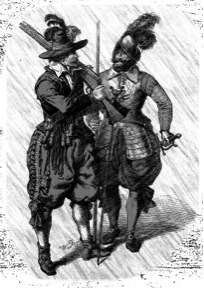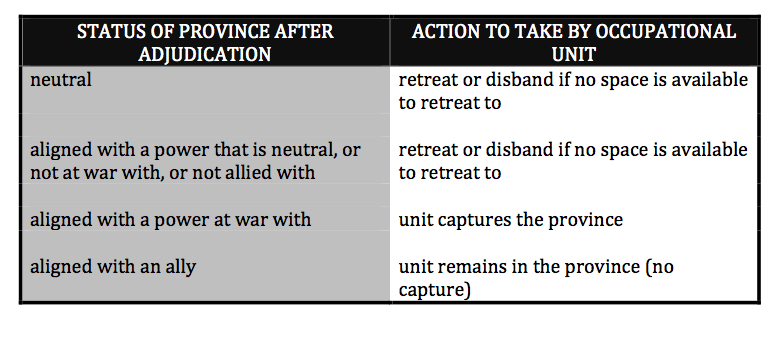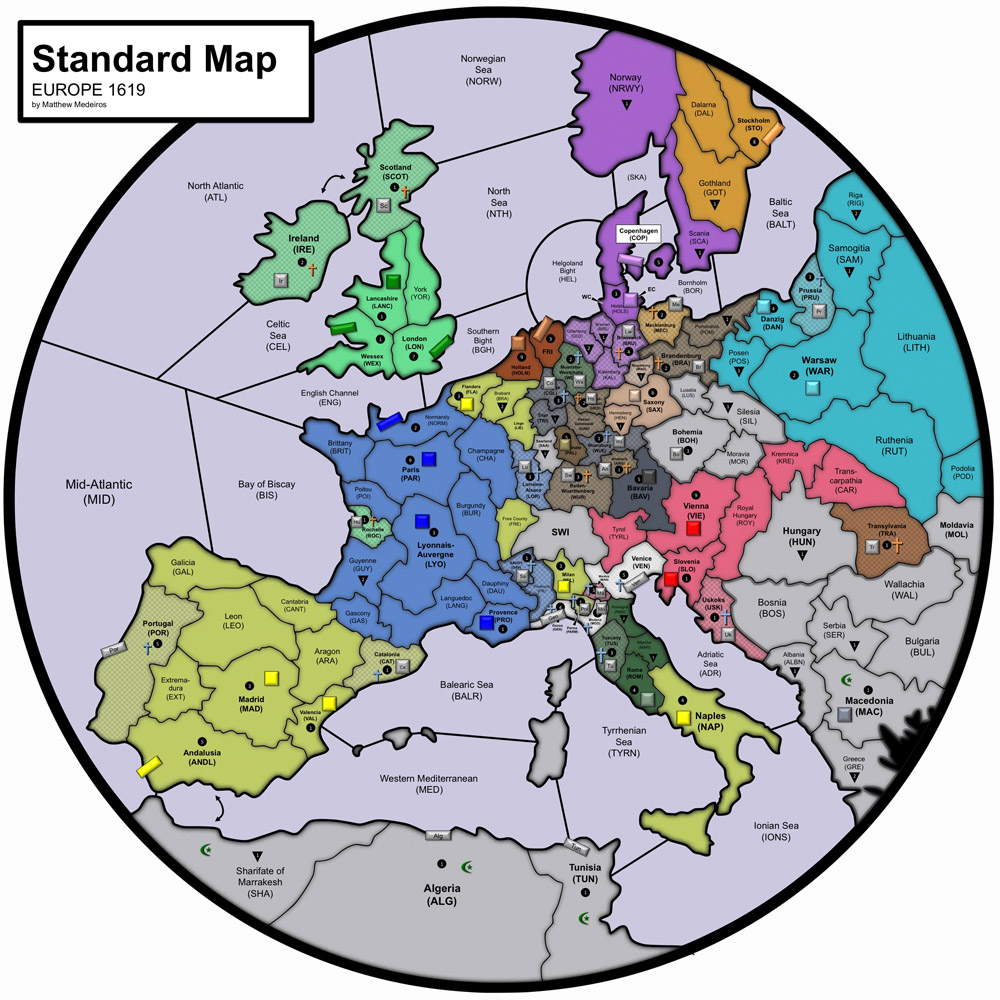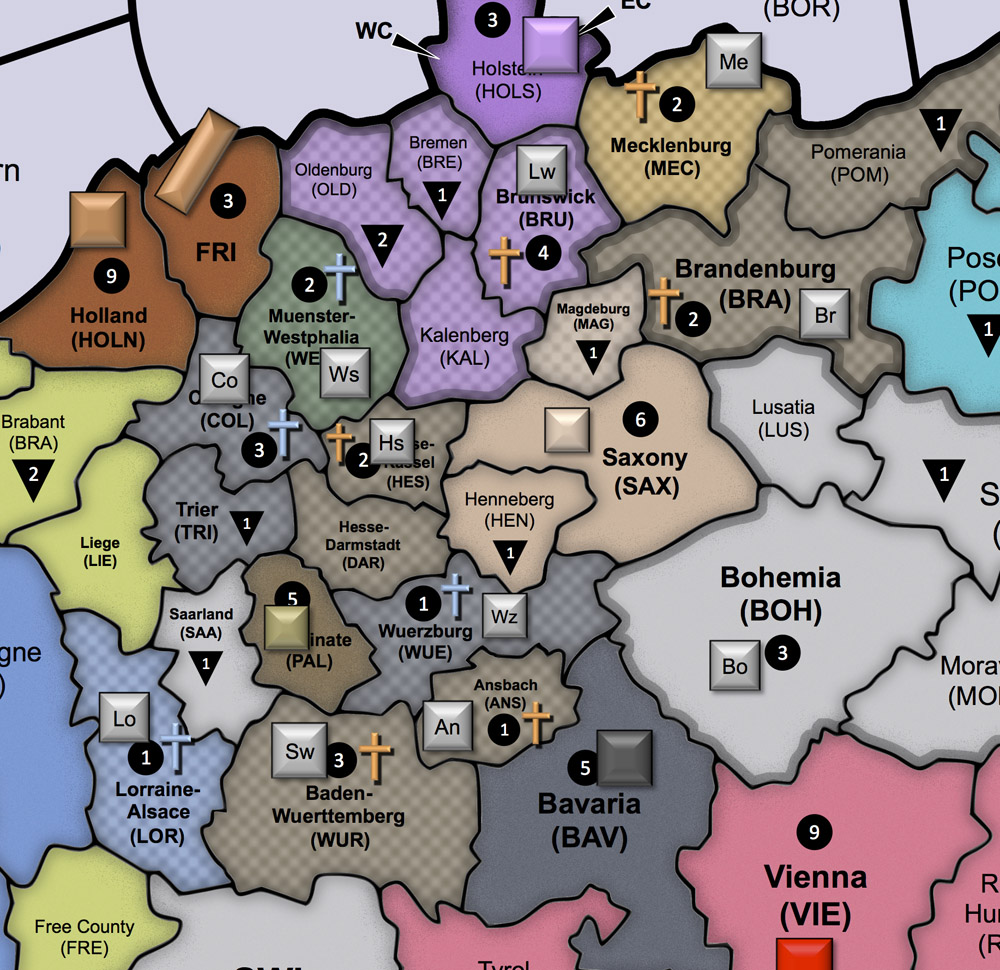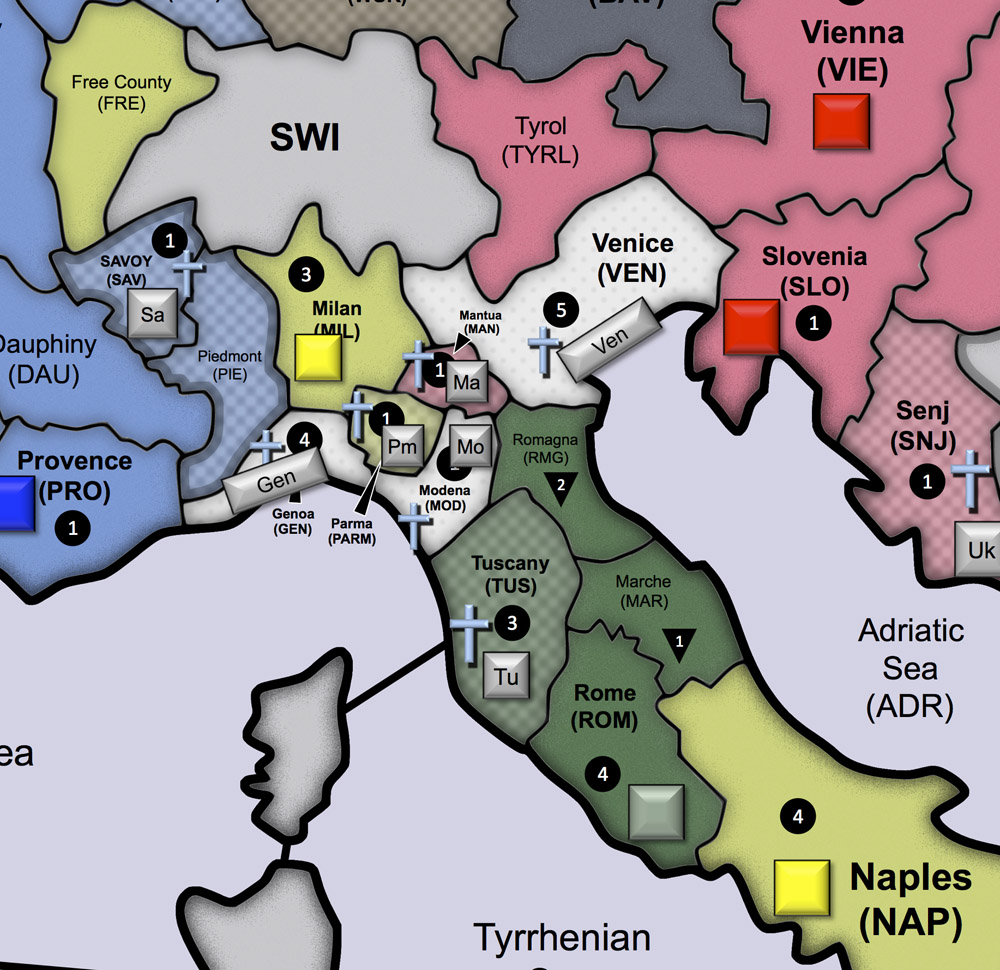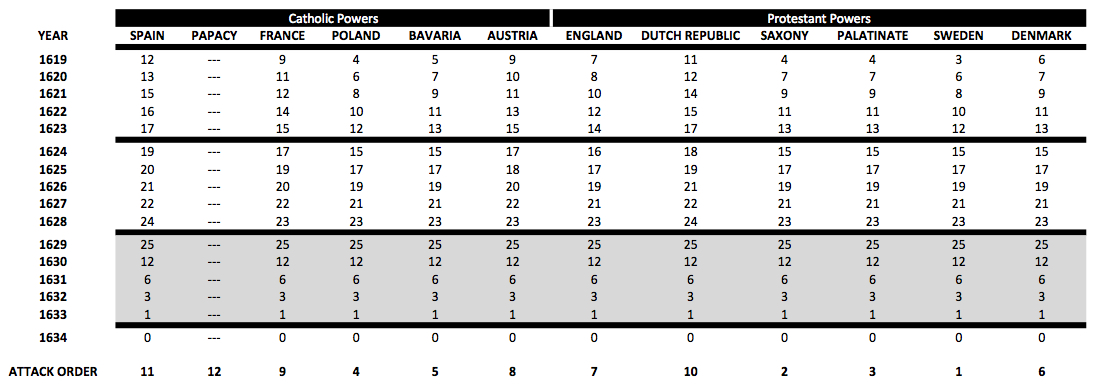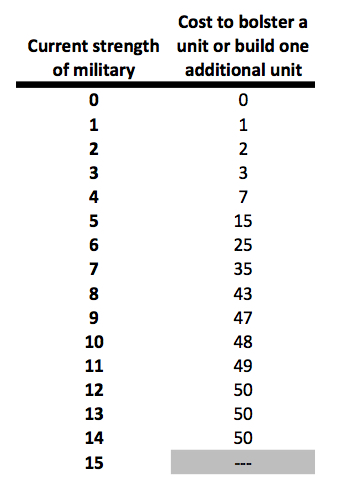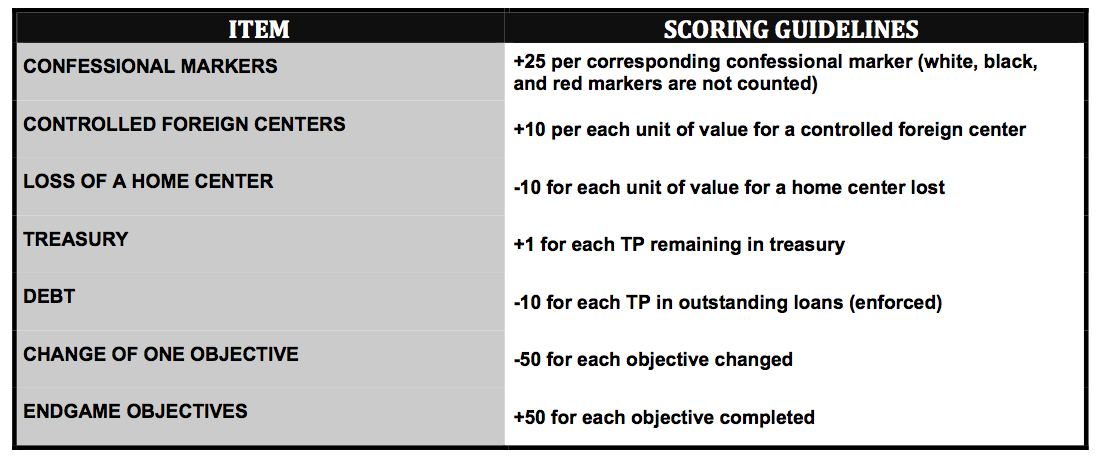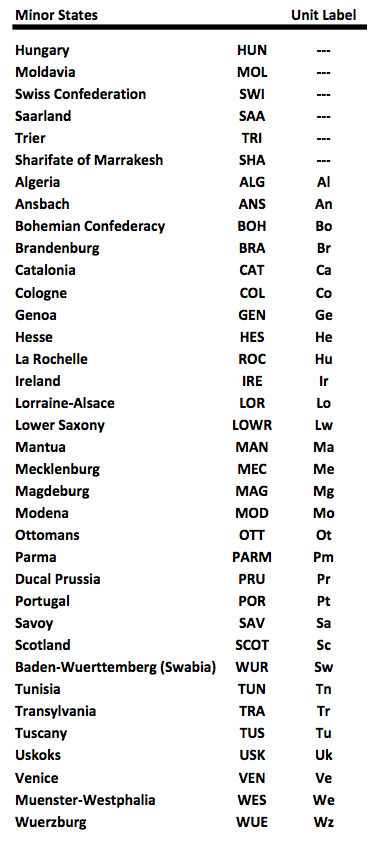Europe 1615: Prelude to War
EUROPE 1619 (formerly called Europe 1615)
A DIPLOMACY VARIANT
by Matthew Medeiros
<This site is going through changes. Not all rules are properly fleshed out at the moment.>
INTRODUCTION
“Had Luther and Calvin been confined before they had begun to dogmatize, the states would have been spared many troubles.” - Cardinal Richelieu
July 31, 1619, Protestant leaders in Bohemia feared the fervent Catholic Ferdinand II, successor to Matthias, Emperor of the Holy Roman Empire, King of Bohemia and Hungary would infringe on their rights. The Bohemian revolt was already in motion, and a confederacy was hatched with Moravia, Silesia, and Lusatia, seeking support, and a leader. Will the Calvinist Frederick V accept the crown, or Lutheran John George of Saxony, or will the Empire’s political and military influence suppress the cause, or maybe, just maybe, events will play out very differently in the hands of shrewd diplomats at the game table…
Europe 1619 is a Diplomacy variant that adopts the mechanics from Jim Dunnigan’s and Thomas N. Shaw’s diplomatic game Origins of World War 2 published in 1971. Various aspects of Europe 1619 are also inspired by other Diplomacy variants such as Ambition and Empire, Classic Payola, Machiavelli, Multiplicity, Juggernaut, and Formal Diplomacy. In Europe 1619, a player represents one of twelve European major and regional powers of the early 17th century:
1 Austria, House of Hapsburg, Ferdinand II
2 Denmark, House of Oldenburg, Christian IV
3 Spain, House of Hapsburg, Philip III
4 France, House of Bourbon, Louis XIII
5 Dutch Republic, House of Orange-Nassau, Maurice of Orange
6 England, House of Stuart, James I
7 Sweden, House of Vasa, Gustav II Adolf
8 Bavaria (Catholic League), House of Wittelsbach, Maximilian I
9 Palatinate (Protestant Union), House of Palatine-Simmern, Frederick V
10 Papacy, House of Borghese, Pope Paul V
11 Poland-Lithuania, House of Vasa, Sigismund III
12 Saxony, House of Wettin, John George I
Europe 1619 attempts to simulate the political and religious struggles of the Protestant and Catholic powers during the early period of the Thirty Years War. Players compete over political and religious control of minor German and Italian states, and other states peripheral to the German theater of conflict. Control of the Ottoman units on the board is assigned to one of the players of a Protestant power, randomly and anonymously. The player with the most points assessed at the end of the game takes victory.
BASIC TENETS OF EUROPE 1619 (HOW STANDARD DIPLOMACY RULES ARE MODIFIED)
Europe 1619 utilizes the standard rules from 5th Edition Diplomacy with noted differences described in this rulebook. Europe 1619 is an asymmetric game, as the various powers begin with differing numbers of units, wealth, and influence. Additionally, Europe 1619 differs from standard Diplomacy in what determines whether an ordered move or convoy into a province is permitted or restricted. This will depend on the status of the province, which can either be neutral (impassable), unaligned (passable), or aligned (conditionally passable). There are no restrictions with the ocean regions other than those established by formed alliances. It should be noted that a unit ordered to support another unit to hold or support another unit moving into a province is always allowed even if the supporting unit is restricted from entering the space it is supporting. The status of a province is dictated by a point-placement mechanic (see Influence and Placement) and by the declarations announced during the game. Another differentiating factor of Europe 1619 from standard Diplomacy is the use of a treasury. A power's military size is not set by the number of centers held, but by the amount of funds available to purchase units or contribute to the military growth of another power. Additionally, an army unit's strength may be bolstered, so that it will defend, attack, support with greater strength. Finally, unlike standard Diplomacy, control of a foreign center requires continuous occupation by the invading force. Given that standard Diplomacy has simple mechanics but complex situations, and given that Europe 1619 incorporates bidding and declarations into the Diplomacy rules set, there will be times when a situation arises that has no particular rule attached, and, therefore, it is at the discretion of the game moderator to provide the ruling.
SETTING OBJECTIVES FOR SCORING
Players should select five (5) objectives for their power, and submit this to the referee. The referee will maintain this list in secrecy and will reveal it at the end of the game. The objectives list will be due at the beginning of second movement phase. This allows a player to submit a provisional list, and make revisions until the due date. After the due date a player is allowed the option to modify the objectives list but at a penalty of 50 points for each objective they wish to change. At the final scoring phase, players receive points for meeting those objectives (see SCORING GUIDELINES). When deciding on the list the player should select one military objective, one political objective, and three strategic objectives. Military objectives are basically occupational objectives, specifically the occupation of a center or a valuable province. For example, France may consider the occupation of Flanders as a military objective. Political objectives consist of alignments. For example, Austria may want Brandenburg aligned by the end of the game. And finally, the strategic objective has flexibility in its shaping. There are five types of strategic objectives, and all strategic objectives in the submitted list should be of different types:
Elimination: Select a power to be eliminated during the game.
Expansion of a minor state: Select a minor state and guide its growth beyond one center, and this does not require that the state is aligned.
Confessional control: Ensure that the number of a chosen confessional marker, Protestant or Catholic, exceeds the number of opposing confessional markers on the board by the end of the game.
Neutral zone: Select a minor state to be neutral by the end of the game. The confession of the state does not need to be specified.
Center count: Occupying the most centers in total (home centers plus foreign centers held) on the board achieves this objective.
Also keep in mind that objectives should not overlap, i.e., if a political objective is set for a minor state, that minor state cannot be used in a strategic objective.
Example objectives list for France:
Political: ALIGNED LORRAINE
Military: OCCUPATION OF FLANDERS
Strategic 1: EXPANSION OF SAVOY
Strategic 2: CATHOLIC CONFESSIONAL MARKERS OUTWEIGH PROTESTANT MARKERS
Strategic 3: ELIMINATION OF SPAIN
PHASES OF THE GAME
Europe 1619 is played over 16 game years. Each game year is divided into the following phases:
1 = Movement Phase
2 = Retreat Phase
3 = Adjustment Phase
4 = Income Phase
5 = Loan and Build Phase
BASIC METHOD OF GAME PLAY
INFLUENCE AND PLACEMENT
Each year Influence Points (INFs) are allocated to the powers as shown in the Influence Progression Table. The exception to this rule is with the Papacy. The Papacy acquires its INFs from the conversion of wealth to influence. Players will distribute their INFs to the independent minor states (see List of Minor States) during a movement phase. [However, there is an initial placement of INFs to the minor states (see INITIAL SETUP).] Players should use all INFs available for the year and may not save unused INFs for the following year. Players cannot distribute more INFs than available for the year, and players may not lend out INFs or remove INFs from a state once they are placed. As the game progresses, INFs will accumulate in each state where they are deposited, and can only be removed or decreased by a diplomatic attack.
To place INFs in a particular minor state, the player must submit an order in the following syntax:
number of INFs: [minor state]
An example of this is 5: BRA, which means that 5 INFs will be placed in Brandenburg.
In addition to placing INFs, the player may also submit a HOLD, MOVE, CONVOY, or SUPPORT order to the unit or units of the minor state. These orders are submitted along with the regular orders for a power’s units for the given movement phase.
States of the Protestant Union: Only Protestant powers may deposit INFs to Brandenburg, Hesse, Baden-Wuerttemberg, and Ansbach.
States of the Catholic League: Only Catholic powers can deposit INFs to Wuerzburg, Trier, and Cologne.
Maghreb states: Morocco, Algeria, and Tunisia cannot be influenced and/or units moved until the Ottomans make first successful move.
THE DIPLOMATIC ATTACK
A diplomatic attack is when a player selects one state where he/she has deployed or will be deploying INFs and then directs a "political" attack against another player/power that also has INFs invested there. The diplomatic attack may be ordered along with the placement of INFs. Each player is allowed to submit only one diplomatic attack order per year and only during the movement phase. The order should indicate the minor state of interest and the target (opponent) of the attack. Typical syntax for the order of the diplomatic attack:
[minor state] > [power]
An example of this is BRA > FRANCE, which means that which ever power submits this order it directs a diplomatic attack against French influence in Brandenburg.
Placement of INFs is determined first before diplomatic attacks are resolved. Diplomatic attacks are resolved by a MUTUAL REDUCTION in the total INFs invested in the state. In the attack, the power with the lesser number of INFs placed removes all INFs and the power with larger number of INFs placed loses equal amount. If multiple attacks are ordered within a minor state, then the sequence of attacks is resolved based on the ATTACK ORDER (see Influence Progression Table).
ALIGNMENTS
The referee only adjudicates the moves AFTER the placement of INFs and the resolution of diplomatic attacks. The referee then reports to the players the statuses of the minor states, presented in a table, as well as in color-coding on the map, and the results of the adjudication of moves based on those new statuses. A state aligned with a power can be thought of as a protectorate or a dependent of that power.
UNALIGNED: A minor state without INFs is considered unaligned (grey-colored). Unaligned states are passable during a movement or retreat phase, and may be occupied.
ALIGNED: If a power holds minimally 50% of all INFs placed in the minor state, then the minor state is considered aligned to the power, and passable or impassable depending on the declarations that have been made. The minor state will then follow any order submitted to the state’s unit(s) by the power it is aligned to.
NEUTRALITY: For two or more powers equally invested in a minor state, the minor state will be marked as neutral (white-colored). Or if 3 or more powers are invested in a minor state, and no one power holds the required 50% for an alignment, then the state is also considered neutral. Neutral states are impassable during any Movement and Retreat Phase. Neutral states can maintain units and maintain control of foreign provinces.
CONFESSIONAL MARKERS AND CONDITIONAL MARKERS
If Protestant powers solely hold the INFs in a minor state with a center then a Protestant confessional marker (orange-colored cross) can be placed in the state. If Catholic powers solely hold the INFs in a minor state with a center then a Catholic confessional marker (blue-colored cross) can be placed on the state. If both Protestant and Catholic powers hold INFs in a minor state with a center, then a confessional marker is placed only when one confession holds twice the number of INFs over the other in the state.
If a state carrying a confessional marker is captured by a unit matching the confession of the state, then the confessional marker is replaced with a tolerant marker (white-colored cross). If the state has an opposing confessional marker to the occupational unit, then a religious rebellion will be in effect, and a rebellion marker (red-colored cross) is placed.
INITIAL SETUP
Before the start the game, there’s a fixed placement of INFs from each power to emulate the historical allegiances of the minor states to the powers at around the year 1619 and 1620.
Initial INF placement goes as follows:
Spain = 10: POR, 1: VEN, 2: PARM, 1: MOD, 1: GEN, 2: CAT
Papacy = 1: GEN, 2: PAD, 1: MOD, 6: TUS, 1: VEN, 4: WES
France = 1: GEN, 2: LOR, 1: MOD, 2: SAV, 1: VEN
Poland = 6: PRU
Bavaria (Catholic League) = 2: TRI, 6: COL, 2: WUE
Austria = 1: GEN, 4: MAN, 1: MOD, 2: CRO, 1: VEN
England = 4: IRE, 2: SCOT, 2: ROC
Dutch = 2: TRA
Palatinate (Protestant Union) = 2: ANS, 4: BRA, 4: HES, 6: WUR
Sweden = 4: MEC
Denmark = 8: LOWR
Saxony = 2: MAG
Based on this distribution of INFs, minor states will be shown on the board as being aligned with one of the major/minor powers, with corresponding confessional markers; and there are three neutral states: Venice, Modena, and Genoa. Bohemian Confederacy, Saarland, Moldavia, Hungary, Swiss Confederation, Algeria, and Tunisia will start off as unaligned states.
CONTINGENCY
Players may submit conditional orders based on the possible status of a minor state through the adjudication. The syntax for the conditional order is:
IF [minor state] ALIGNED WITH [power] THEN [orders] ELSE [alternate orders]
For example, France may write in a set of orders to anticipate a change in the alignment of Savoy during the adjudication.
IF Savoy ALIGNED WITH Bavaria THEN SAV HOLD ELSE SAV-PIE
Players are allow to submit up to 2 conditional orders as shown above per movement phase.
DECLARATIONS AND MOVEMENT
Declarations allow players to declare war, to announce alliances, to take a neutral stance, or to end war. During any movement or retreat phase no power or aligned minor states of that power can move into the territorial domains of an opponent power and its aligned states unless a declaration of war is made or an alliance is in effect. All declarations must be submitted during a movement and phase and recorded in the adjudication. The declaration then becomes effective during the next year's movement phase. Declarations do not restrict movement on the open seas, i.e., a non-coastal fleet can attack or be attacked by a non-enemy or non-allied unit. Water regions are always contested, but the rules of alliances must be observed. Declarations have no affect on diplomatic attacks (i.e., a power can perform a diplomatic attack against an ally within a minor state); for an exception to the rule see dynastic alliance.
Declaration of war against another power: Declaration of war with another player may be announced during a movement phase, and becomes effective in the next year's movement phase. Declaration of war is made against an opposing power and all of its aligned states. Therefore, if a power wishes to attack an opponent-aligned minor state, whether directly or indirectly with an aligned minor unit, it must declare war on the power that the targeted minor state is aligned to. If no declaration of war has been made, this is what is allowed: (1) Declaration of war is not required for a power or minor state to move against an unaligned minor state. (2) A unit may support holds, convoys, or support movement into a province with or without a declaration of war. (3) Movement into a province (i.e., as to cause a standoff) is restricted unless a declaration of war is in effect or an alliance has been made.
Note: All these rules assume that the status of a province does not change after the adjudication. It is quite possible that an ordered move into an unaligned province, for example, may fail if the status of the province changes during the adjudication.
Declaration of neutrality: When a player declares neutrality, no other player can declare war against this person. The option to declare neutrality is only allowed if the power is not presently at war with another. Declaration of neutrality has priority, so if a player makes a declaration of war against an opponent at the same time that the opponent declares neutrality, the declaration of war is ignored.
Alliances: Declaration of an alliance with another player may be announced during a movement phase, and becomes effective in the following year's movement phase. All potential members involved in the alliance must make the declaration for it to be official. Alliances allow the following: (1) A member of an alliance CAN move freely through the territories and centers of another ally; this includes aligned minor states of the member. A member of an alliance CANNOT dislodge or support the dislodgment of an ally’s unit (including the aligned minor units of the ally), even if that dislodgment is unexpected. An attack by a power on an allied unit does not cut support. This also applies to minor states aligned with the ally. Allies cannot capture each other's centers or the centers of their aligned states, but may occupy those centers (see Occupation by Proxy). Breaking from an alliance can be initiated by any member of the alliance and declared during one movement phase and made effective in a subsequent year's movement phase. If a power occupies a home center of a former ally the year after the declaration of separating from the alliance, the power's unit must move from the home center or disband (see rules regarding major and minor units). In an alliance, a power is not held liable if an ally declares war against another power. For example, if France and Denmark are allies, and France declares war against England, Denmark will not be at war with England, unless a declaration of war is made by Denmark or England against the other.
Dynastic alliance: This alliance has the same benefits of a regular alliance with the following supplementary rules:
- Dynastic alliance can only be made between two powers.
- The alliance does not allow one member to conduct a diplomatic attack against the other member.
- The alliance may only be announced once. If it dissolves later in the game, it can no longer be remade.
- The alliance must combine score for determination of overall victory at the end of the game.
- If one member is eliminated or ends in civil disorder, all of its INFs on the board are converted to the INFs of remaining member.
Declaration of surrender: A player may surrender to an opposing power to save his position in the game. A surrender made in one movement phase becomes effective in a following year's movement phase. Surrender comes at a price. The victorious power can levy an indemnity against the surrendering power. This would be an agreed upon sum between the two parties. The indemnity should be divided equally between members of a victorious alliance.
Armistice: Players at war may use any movement phase to announce an armistice to officially end hostilities. The armistice becomes effective in the following movement phase.
Sequence of declarations: If two players are in an alliance, then come into conflict, the alliance must first be dissolved before war is declared against each other. If two players are at war, and then find that an alliance would be beneficial, the conflict must first end before the alliance can be formed. This also applies to neutrality. If a neutral power wishes to declare war it must first end neutrality. Example: France and England are at war in 1623, but decide to end war and form an alliance. Then the announcement to end war occurs in 1624, becomes effective in 1625. In 1626 (or any year thereafter), England and France can now make a declaration of an alliance to be effective in the following year. It’s important to note that in 1625 until when an alliance comes into effect, France and England are neither at war or in an alliance, and this will prevent a move or convoy of one power into the territories of the other.
RULES REGARDING MAJOR AND MINOR UNITS
(1) Any unit is automatically disbanded if dislodged. For an exception to this rule see item (4) and the rules covering the bolstered unit.
(2) A power cannot attack, dislodge, or support the dislodgment of an aligned minor state's unit, even if that dislodgment is unexpected. An attack by a power on an aligned minor unit does not cut support. [Example: Hesse is aligned with France. France cannot cut the support of a Hessian unit nor support the dislodgment of that unit.]
(3) The capture of a minor state's home center leads to the disbanding of all its units, and the relinquishing of control of any foreign centers/provinces during the Adjustment Phase.
(4) At the end of a movement phase, units should be evaluated on whether they can maintain their positions in a province which depends on whether the status of the province has changed during the adjudication. See table below on what actions to take.
(5) Movement impediment: There are certain situations when a minor unit will not follow the move order of an aligned power. Movement impediment is determined ex post adjudication, that is, after the movement/activities of adjacent units to the minor's home center are adjudicated. Enemy units adjacent to the minor's home center impedes movement of the minor's unit. These rules do not apply to a foreign center held by the minor state; if ordered to move from a foreign center the unit will commit. Nothing restricts the minor unit from following a support order. Adjacent allied units do not restrict movement. A minor unit may move from its home center when there are no adjacent enemy units (and this does not include the province where movement is directed); otherwise, movement is restricted. Once the unit successfully moves from its home center, it will continue to commit to orders given by the power it is aligned to.
SECURING CONTROL OF A CAPTURED FOREIGN CENTER
For a power or a minor state to maintain control of a foreign province or foreign center, it must maintain occupation. If the province is no longer occupied at the end of the movement phase, it immediately reverts back to its independent status during the adjustment phase. A controlled minor state cannot be influence by any power; however, all INFs invested in the state are held in suspension, not removed or altered except by a diplomatic attack. A power may relinquish control of a center/province to reestablish its independent status by simply removing its occupational unit. When a state is released, the INFs that were held in suspension are put back into effect, and its political status reestablished, and its unit rebuilt (if it has a center).
Occupation by proxy: Since a power or minor needs to maintain occupation of a foreign province to maintain control, how can a power/minor maintain control if the occupational unit needs to move? You can substitute an aligned minor unit for your unit in a foreign province/center, or an ally’s unit, or a unit aligned with your ally, and thus you may still maintain control of the province or center.
Transferring control: During the adjustment phase, if there is occupation by proxy, you may transfer control of the province to the minor unit or another power that occupies it. This is done by simply making a public announcement. However, the reverse cannot take place, i.e., a minor state cannot transfer control of a province to a power.
Relinquishing control: If a territory of a power (or minor state) is taken by a foreign unit, and then later foreign-control is relinquished, the territory is restored to the domain of that power/state. Example: Normandy is occupied by an enemy English unit. England then withdraws leaving Normandy unoccupied. Normandy is restored to France at the adjustment phase. This rule applies to minors as well. Therefore, Bremen, Oldenburg, Kalenberg, which are part of Lower Saxony are restored when no longer held by a foreign unit; this applies also to Pomerania, as part of Brandenburg; Piedmont, as part of Savoy; Darmstadt as part of Hesse; Silesia, Moravia, and Lusatia as parts of the Bohemian Confederacy; and any of the many provinces of the Ottomans (unless eliminated).
RELIGIOUS REBELLION
If a controlled center carries an opposing confessional marker to the occupational force then the state will be considered in revolt (confessional marker replaced with red-colored marker). A revolting state does not allow an occupying power to collect income on the center. The revolt quells after a given number of movement phases. This is determined from the value of the center or province. For example, if the Dutch secure control of the Flanders (FLA) in 1620, the state is in revolt (a Protestant power capturing a Catholic province). FLA has a value of 3; therefore, the revolt will end in 1623 (3 years later). The revolt ends at the adjustment phase of 1623, at which time the red-colored marker is replaced with a black-colored marker and the Dutch begins collecting income during the income phase of 1623. The Dutch will be unable to collect income on FLA from 1620 to 1622. A revolt will immediately end if the center is "liberated" by a matching confessional unit.
RETREATS AND THE COMBAT ATTRITION RULE
Units cannot retreat (applies to both fleets and armies). However, a multi-strength (bolstered) army unit can retreat if an open space is available and one that is not in rebellion. When a multi-strength army unit is forced to retreat, it loses one unit of strength. If a multi-strength unit is dislodged but unable to retreat, it is completely removed from the board.
INCOME PHASE AND WEALTH
Each player begins with a treasury with 10 units of wealth called treasury points or TPs (players may settle on a particular unit name for the period such as millions of ducats, millions of florins, or millions of talers). During the income phase all players receive income (as TPs) from home centers and controlled foreign centers (value within a black circle as shown on map) and controlled provinces with an income value (value within black triangle as shown on map). A home center under foreign occupation is in revolt if the occupier’s confession is opposing, and thus, does not provide income until the revolt has ended. A home center under foreign occupation by an enemy unit does not provide income except to the occupying power unless it is in revolt.
Protestant Union, Catholic League, and the Papacy: The Palatinate, Bavaria, and the Papacy may garner additional funds from aligned states at the rate of half (rounded up) of the value of the states that are aligned. Example: The Papacy will garner 2 TPs from Tuscany, 1 TP from Muenster-Westphalia, and 1 TP from Paderborn at the income phase of 1619 as long as these states remain aligned.
Protestant war fund: Protestant powers may agree to establish a war treasury where all Protestant powers may, at their discretion, contribute funds each year. For any one Protestant power to access the war funds, the other Protestant powers must have a majority agreement to this.
‘’’Bohemia and Austria:’’’ If Austria gains the alignment of Bohemia, it will garner half of the value of the state (rounded up) during the income phase. This amounts to a total of 3 TPs assuming Silesia, Moravia, and Lusatia are not occupied by a foreign enemy unit.
‘’’Rochelle and France:’’’ If France gains the alignment of Rochelle, it will garner half of the value of the state (rounded up) during the income phase. This amounts to a total of 1 TP.
Loans: This game allows for players to give and receive loans. Players may give grants as well without repayment. If a player gives a loan, then the player should expect a repayment on an agreed upon time without interest, in parts or full. If a player gives a loan, he/she may demand an interest payment along with repayment (range of 20%-50% applied immediately, and may be fixed, or compounded yearly). These scenarios are monitored by the referee, but not enforced by the referee and the recipient of a loan is not penalized for defaulting. However, if a player wishes to enforce the loan and the interest on the loan, then all parties must agree on the involvement of the referee to monitor whether or not the recipient is penalized for defaulting. The referee can also give loans (a maximum of 25 units of wealth) with fixed interest rate of 50% compounded per year, applied immediately, and penalizes when the recipient defaults. The penalty for debt is shown in the scoring guide.
BUILDING A NEW UNIT AND THE MULTI-STRENGTH UNIT
During the income and build phase players may “purchase” units based on the Military Cost Table. The cost to add one additional unit is equal to a value based on the current strength of the military. The power must have an unoccupied home center for a new build to be allowed. The number of units that may be added is limited by the treasury and unoccupied home centers. To calculate the cost to add more than 1 unit during this phase, the player must assess the cost of one additional unit after one unit has been purchased. No power can have more than 15 units on the board (or a combined military strength greater than 15). For total strength of a military, just count up all the strengths of the units of a power on the board.
Example: France wishes to add two units during the income and build phase. At a military size/strength of 4 units, it will cost 8 TPs to add one more unit. To add the second unit, France considers the new size of the military at 5 units. From 5 to 6 units, it would cost an additional 15 TPs, provided that the purchase does not put France below 0 TPs in the treasury. If that is the case, then France cannot build the second unit.
Bolstering the strength of an army unit: In the same manner as building a new unit, a player may increase the strength of an ARMY unit only. The unit must be on a home center for its strength to be bolstered. (Additionally, a unit on an aligned state's home center may be bolstered as well; i.e., French unit moves into the French-aligned Savoyard center, France may bolster the strength of that unit.) In the same manner as above, one needs to determine the overall strength of the military and then find the cost of adding a new unit or increasing the strength (see table). A player may, during the build phase, reduce the strength of a bolstered to allow for a new build in a home center. However, a player CANNOT reduce the strength of unit and bolster the strength of another during the same build phase; nor can a player disband a unit and bolster another in the same phase.
Moving a bolstered unit: A unit with bolstered strength is not treated as multiple units when moving on the board, but as a single unit with greater strength than 1. The unit cannot be split apart (however, its strength may be reduced by a retreat), nor can it merge with others. The multi-strength unit moves, attacks, defends, and supports with the greater strength. When a unit has greater strength this is depicted on the board with plus sign and value on top of the unit. So a unit with a strength of two is shown with a +1 on the top; a unit with a strength of 3 is shown with a +2 on top, etc. The maximum that a unit may be bolstered to is 10 (labeled with +9). Additionally, the support of a multi-strength unit can be broken by an attacking unit (or the combined strength of attacking units) in a one to one reduction (i.e., if a unit supporting with strength of 2 is attacked by a unit of strength of 1, then the support given will be rated at 1.
Minor states: Minor states build based on the number of centers it holds: Number of units that a minor can maintain is equal to number of centers it holds (that is the home center and controlled foreign centers), and builds are allowed if the home center is unoccupied. Minor states will automatically build a unit if it becomes independent from when a power or another minor relinquishes control of it. Coastal states will by default build fleets, but the aligned power may indicate the preferred unit. The strength of a minor state's unit cannot be bolstered.
THE PAPACY
The Papacy is a special regional power in the game. It has special rules attached as shown below (with exceptions given):
(1) No Catholic power can declare war on the Papacy. The Papacy can declare war against any power. Exception: If the Papacy is allied with a Catholic power that is at war or declares war on another Catholic power, then the Papacy may be the recipient of a declaration of war from that Catholic power. If a Catholic power is allied with another Catholic power (or a Protestant power) that declares war on the Papacy, then the Catholic power must either break from the alliance, or declare war on the Papacy as well. If the Papacy expands its ownership beyond 5 centers, then any Catholic power may declare war on the Papacy. See below on Papal Decrees for other exceptions.
(2) The Papacy must contribute minimally 1 TP of its wealth to a Catholic war fund (or a war treasury) each year. Other Catholic powers may donate to this fund. The Papacy cannot access funds from the war treasury except by a majority agreement from the other remaining Catholic powers.
(3) The Papacy is the only power that can use wealth to create INFs. At the first income phase, the Papacy may allocate 1 TP to make 1 INF, and these INFs will be available for the coming year. No exceptions. The number of available INFs is announced by the referee at opening of the subsequent year.
(4) The Papacy may use decrees to regulate the activities of the Catholic powers. No exceptions.
Papal decrees: Decrees are essentially commands to Catholic powers only, announced during a movement phase, and made effective in the following movement phase. One decree can affect up to three powers. Only one decree can be announced per year, but the player is not obligated to announce one each year. A decree of annulment can be announced to repeal one decree in effect, and this in turn ends a penalty, if any, incurred by the affected power from that decree. Decrees can be made in the first year. Here are some examples of a decree:
The Papacy commands France not to enter a unit in the Lorraine.
The Papacy instructs Spain not to enter in an alliance with Sweden.
The Papacy urges Austria and Spain and Bavaria not to perform a diplomatic attack against French influence in Westphalia.
The Papacy warns Bavaria from influencing Lower Saxony.
The Papacy demands Spain and France to withdraw from an alliance with England.
The Papacy abolishes the decree that hinders French occupation of the Lorraine.
The player of the Papacy may utilize this ability to influence the tactics in the game, and may be as creative with the decrees as allowed by the referee (however, the Papacy cannot force a player to declare war on another or occupy a province). Decrees can be passed after the fact if the activity can be changed (i.e., if France enters the Lorraine, the papacy can pass a decree against French occupation of the Lorraine giving France the time to vacate; however, if France places INFs in the Lorraine, the Papacy cannot pass a decree against the French influencing the Lorraine unless French INFs are eliminated by another power through a diplomatic attack). Can a Catholic power ignore the decree? Yes. Decrees are a form of interference, and a Catholic power may be unhappy with the passing of these decrees. Therefore, if the Papacy passes more than 5 decrees in the game, any Catholic power may declare war on the Papacy. If a Catholic power ignores a decree then a 5-point penalty is levied against the power, each time. Any penalties levied by the Papacy against any Catholic power, including excommunication, will be voided if the Papacy is eliminated.
Rule of escalation and excommunication: What if a Catholic power ignores each and every decree? A Catholic power has the luxury of ignoring up to 5 decrees. After which, the Papacy may pass a decree of excommunication against that power. Excommunication carries a 50-point penalty at the end of the game. Papacy also has the right to reverse an excommunication. This restarts the counting of violations for the power in question, before the papacy can reestablish the excommunication.
Financial support: If a Catholic power is at war with a Protestant power, the Catholic power may request financial support from the Papacy. The Papacy is obligated to loan TPs from the Catholic war fund if funds are available; that is, give a one-time free grant of wealth for builds or payment of outstanding loans accrued by the Catholic power. After the first grant, the Papacy has the option to continue or discontinue the support if further requests are made. If not enough funds are available through the Catholic war fund, the Papacy may contribute funds from its own treasury, optionally, in the same manner that all powers may give loan or grants to other powers. If a Catholic power is at war with another Catholic power, it is at the discretion of the Papacy to support one or the other or both.
THE OTTOMANS
The Ottomans have a special set of rules for movement. Although the Ottoman territories are greyed on the map, they are not treated as an unaligned state. An attack on the Ottoman territories will require a declaration of war. Before the start of the game, the referee will randomly select a Protestant power to secretly move the Ottoman units. Additionally, at least one more player will be secretly selected as an alternate to control the Ottoman units. These players are collectively called the 1st and 2nd HANDLERS. All players may place INFs into the Ottoman Empire, but only the handlers can submit orders. The Ottomans only move when aligned to a power, and Ottoman units hold when unaligned or neutral. During the course of the game, if the first handler does not have the alignment of the Ottomans his/her orders are followed if and only if the Ottomans are aligned with a power. The orders submitted by the other handler are ignored. If the first handler fails to submit orders, then the orders submitted by the second handler will be followed. If the first handler gains the alignment of the Ottomans, then his/her orders are ignored, and the orders of the second handler are used only. If this situation occurs, the first handler is no longer able to order the Ottomans and a new handler is randomly selected. The 2nd handler is promoted to the 1st, and the newly-selected player takes 2nd. The process is then repeated if the newly-promoted 1st handler gains the alignment of the Ottomans. If any power gains the alignment of the Ottomans, then the Ottomans are treated as an ally. Apply the rules of alliances in this case. Ottomans build automatically in the same manner as the minor states. If a power is at war with the Ottomans, that power will be unable to deposit INFs to the Ottomans. The Ottoman units are also bound to the movement restrictions described above for minor units. This also means that the 1st handler is responsible for making declarations for the Ottomans, primarily the declaration of war, and declaration of armistice. The Ottomans cannot make a declaration of war against an aligned power. Likewise, an aligned power cannot declare war against the Ottomans. However, any other power with no relationship to the Ottomans may declare war on the Ottomans.
ELIMINATION
A power that is no longer in control of all its home centers is considered eliminated, irrespective of controlled foreign centers. When a power is eliminated, all units are disbanded at the adjustment phase, and the foreign centers that were held are then liberated, restoring them as independent minor states; and to their pre-occupational status. INFs from the eliminated power are removed from all minor states where the power has invested, and the statuses of these minor states reevaluated.
Important rules about elimination: Spain is eliminated if Madrid, Valencia, and Andalusia are captured. Southern Netherlands, Milan, and Naples become independent states.
MID-GAME AND FINAL SCORING
Game ends at the opening of 1635. Referee may score players mid-game, say, anytime between 1624 and 1628, so that they can gauge their progress without revealing the objectives. On the year that the game ends, the referee tallies the final score based on the guidelines shown in the Scoring Guide. Player with the highest score or the dynastic alliance with the highest score wins the game. In case of ties, players may agree to extend the game to break the tie, or call a draw.
NOTES ABOUT THE BOARD
Large states: Several minor states are composed of smaller provinces as shown below. When a political status is established for these states, all provinces of the state are identified as aligned or neutral.
Lower Saxony (LOWR) = Bremen, Oldenburg, Kalenburg, & Brunswick-Lunenburg
Savoy (SAV) = Savoy proper (SAV), and Piedmont (PIE)
Hesse (HES) = Hesse-Kassel (HES), and Darmstadt (DAR)
Bohemian Crown or Confederacy (BOH) = Bohemia (BOH), Lusatia (LUS), Moravia (MOR), Silesia (SIL)
Brandenburg (BRA) = Brandenburg proper (BRA) and Pomerania (POM)
Ottoman Empire in the Balkans (OTT) = Macedonia, Greece, Bulgaria, Serbia, Albania, Bosnia, and Wallachia.
Coastal province: Holstein (HOL) has two coasts. Moving a fleet from Copenhagen to HOL requires that the coast be specified. HOL (EC) – HOL (WC) or visa versa is not a legal move.
MODIFICATIONS FOR A GAME WITH LESS THAN 12 PLAYERS
11 PLAYERS: Convert Saxony to an independent minor state. Reduce its center value to 3. The Palatinate and Bavaria each have 1 INF invested in Saxony to start.
10 PLAYERS: Modify Saxony as described above. Convert Poland into independent minor state. Rules for controlling Poland will be exactly the same as for the Ottomans. Randomly and anonymously select a player of a Catholic power to start as the 1st handler.
9 PLAYERS: Modify Saxony and Poland as described above. Convert Sweden into an independent minor state. reduce Sweden’s center value to 4. Only Protestant powers will be allowed to deposit INFs to Sweden.
8 PLAYERS: Modify Saxony, Poland, and Sweden as described above. Convert Papacy into independent minor state. Reduce Papal center value to 2. Only Catholic powers will be allowed to deposit INFs to the Papacy.
7 PLAYERS: Modify Saxony, Poland, Sweden, and the Papacy as described above. Convert the Dutch Republic to an independent minor state. Reduce value of Holland to 5. Only Protestant powers may deposit INFs to the Dutch Republic.
PLAY-TESTERS
My gratitude to the following individuals for their time in play-testing of and making suggestions for this variant:
Adam Bagley
Jonathan Langman
Bryan Laferriere
Christian Schanner
Brian Diffell
Shane Cagney
Poul Hurup Lund-Andersen
Matthew Kelly
Michael Walters
Ewoud Wiering
Chris Lee
Chun Wang Lau
Andrew Port
Mark Utterback
Max Victory
Steven Caponigri
Aaron Havas
Greg Bim-Merle
Hugh Polley
Leonard Saffer
TABLES AND MAP
Europe 1619 Map and Starting Positions
The standard map is very large so close-ups are shown below.
Close-up of Germany
Close-up of Northern Italy
Influence Progression Table
Military Cost Table
Scoring Guidelines
